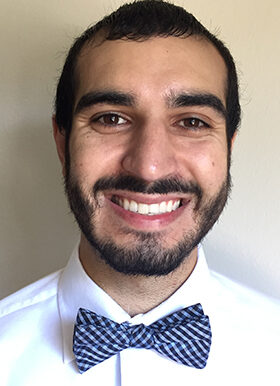
Simon Haroutounian, PhD, MSc
Chief of the Division of Clinical and Translational Research (DoCTR); Chief of Clinical Pain Research, Washington University Pain Center
- Email: sharout@nospam.wustl.edu
Research Interests
The research focus in the Haroutounian lab is on chronic pain. Pain is one of the leading causes of disability worldwide and is the single most common reason people seek medical care. While acute pain episodes can be treated reasonably well in most cases, chronic pain – which affects about 20% of the adult population –largely remains inadequately treated. Particularly challenging is neuropathic pain, a consequence of damage or disease affecting the somatosensory nervous system.
Chronic pain comes in many shapes and forms. It may be related to other medical conditions (e.g. diabetes, stroke, multiple sclerosis, or cancer), be of unknown origin, or be a result of treatment such as surgery or chemotherapy, that was aimed to cure a disease or improve the person’s quality of life. Regardless of the origin, chronic pain often results in impaired function and quality of life and prevents living life to the fullest.
It is an enormous and costly challenge to match the right analgesic treatment (or combination of treatments) to the right patient – the therapy that will allow good pain relief and improved quality of life but will not cause side effects. Currently, this individual treatment “tailoring” is more of an art than a science.
By applying translational research, we explore methods to prevent chronic pain when possible, and to make the individualized pain management a science.
Dr. Haroutounian is the Chief of the Division of Clinical and Translational Research (DoCTR), an Associate Professor of Anesthesiology, and the Chief of Clinical Research at the Washington University Pain Center. Dr. Haroutounian has obtained his BSc.Pharm and MSc.Pharm degrees, as well as his PhD, from the Hebrew University of Jerusalem. He has completed a Fulbright doctoral fellowship in pain outcomes research at the University of Utah (2008-2009, with Prof. Arthur G. Lipman), and a post-doctoral fellowship in clinical pain research at the Danish Pain Research Center in Aarhus, Denmark (2011-2013, with Prof Troels S. Jensen).
Research Topics
1. Investigating individual mechanisms, risk factors, and intervention methods to prevent chronic pain after surgery.
Persistent postsurgical pain (PPSP) is an undesired and a quite common consequence of many surgical procedures, such as amputations, thoracic and breast surgeries, and joint replacements. As an iatrogenic condition, it may be possible to reduce its incidence and severity, once we gain enough knowledge of the individual risk factors and mechanisms associated with PPSP. Some of our previous work has addressed the possible mechanisms (Haroutounian, 2013), contributive factors (Vila, Todorovic 2020, Willingham 2020, Willingham 2021, Lim 2021, Sharma 2021), and preventive approaches (McNicol, 2014), and we continue to learn about the epidemiology and to investigate novel approaches of identifying high-risk patients and applying personalized approaches for possible prevention of PPSP.
2. Predicting individual response to pharmacotherapy in patients with chronic (predominantly neuropathic) pain, by using sensory phenotyping approaches and comprehensive pharmacokinetic analysis and modeling.
We have a major interest in investigating individually tailored analgesic pharmacotherapy approaches. By using methodologies that include pharmacogenetics, pharmacokinetic analysis, morphological and functional nerve fiber characterization and psychological evaluation (Ginosar 2016, Hincker 2019, Chiang 2020, Chiang 2021) we aim to identify predictors of individual response to pharmacological interventions in neuropathic pain arising from different conditions such as diabetic neuropathy, chemotherapy-induced peripheral neuropathy, and post-traumatic or post-surgical neuropathy.
3. Understanding the individual clinically-relevant mechanisms involved in central and peripheral neuropathic pain.
Following peripheral nerve damage – molecular, morphological and functional changes occur not only in the injured nerve axon, but also in the cell body in the dorsal root ganglion, and within the CNS – particularly in the spinal cord dorsal horn. The combination of these peripheral and central changes (which is highly variable at the individual level) contributes to the ongoing pain and sensory changes that the patients experience. The central changes that lead to increased signal amplification at the spinal cord level and decreased descending pain modulation from supraspinal sites are termed “central sensitization” – a phenomenon that has been a subject of increased research and clinical interest recently. We have shown that central sensitization on its own does not generate or maintain chronic neuropathic pain (Haroutounian, 2014, Haroutounian 2018, Buch 2019) and continue to investigate the individual characteristics that may shed light on the relative contribution of peripheral vs. central mechanisms in driving different types of neuropathic pain (Karlsson 2019, Haroutounian 2021).
4. Understanding the clinical role of the endocannabinoid system and cannabinoids in pain.
The endocannabinoid system regulates a myriad of cognitive, emotional, sensory and metabolic processes, including pain. Considering this complexity, attaining the ability to interfere with the endocannabinoid system in a selective manner to attain analgesia without interfering with the other systems has proven to be a substantial challenge. We have been involved in numerous studies and initiatives for understanding the mechanisms of cannabinoid medicated analgesia and synthesizing the evidence of the efficacy and safety of cannabis and cannabinoid-based medicine for the treatment of pain (Haroutounian 2016, Moore 2021, Fisher 2021, Haroutounian 2021, Soliman 2021, Finn 2021, Haroutounian 2021)
Science Communication
Can we predict which patients with painful chemotherapy-induced peripheral neuropathy respond to treatment with pregabalin (Lyrica)? Learn more by visiting the link below.
Publications
A comprehensive list of Dr. Haroutounian’s publications can be found by visiting the link below.















